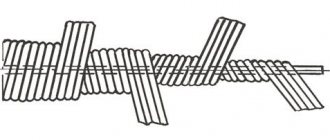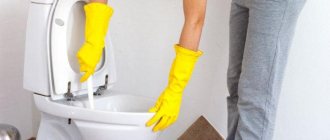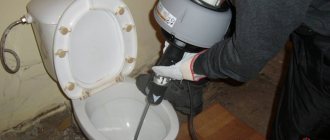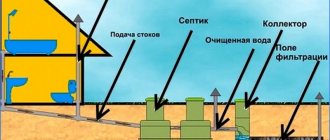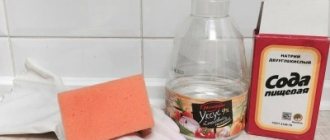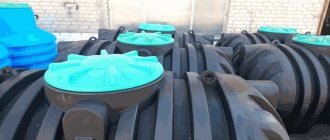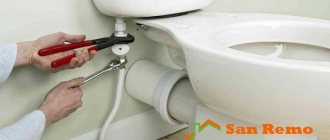The toilet is clogged - what to do at home and how to clean it? A clogged toilet is like a natural disaster - it occurs suddenly, requires immediate action and turns the life of household members into a real nightmare. The vast majority of people immediately begin frantically digging through the phone book in search of the treasured telephone number of the housing office emergency service. But hopes for brave and fast plumbers begin to fade over time - utility services are not in a great hurry to help. In this regard, you have to think about independent measures to remove the blockage and resume your usual way of life, without going to your neighbors “out of need.”
First, you need to figure out why such a blockage occurred, what could block the normal passage of sewage through the pipes, and what to expect from this situation.
Features of home sewerage
Sewage is an integral part of the drainage and water supply system.
It is designed to remove liquid and solid products of human activity, to purify household water from contaminants and return them for further use or into a reservoir. A sewerage system is necessary for comfortable living in a house or apartment. Residents of apartment buildings are responsible for the condition of sewer pipes in the apartment, and owners of private properties must independently install local treatment facilities, remove sewage, and maintain pipelines and equipment.
In order to avoid unpleasant problems in the future, you should comply with the requirements of SNiP regulations on water drainage and sewerage. Then the system will work normally, without requiring constant monitoring or adjustment.
Having a properly designed and installed sewerage system will make life more comfortable, help maintain environmental balance on the site and extend the life of buildings
The internal sewer networks include:
- plumbing fixtures with water drainage;
- common riser which sewer pipes are connected;
- pipe layout that ensures the process of transporting wastewater from the drain hole to the riser.
Requirements for internal networks are specified in SNiP “Internal sewerage”, in GOST and SNiP “Sewerage”. The systems are installed inside the building and ensure the transportation of all wastewater from the place of its formation to the pipe exiting the building.
Basic requirements for internal networks:
- When installing plumbing fixtures on drains, a water seal is required.
- Cast iron or plastic pipes are used for laying networks.
- The diameter of the sewer system outlet from the house is at least 110 mm.
- When laying pipes, a slope of 2 to 2.5% must be maintained.
The internal networks of the sewer system must be equipped with ventilation. The process of ventilating the networks is carried out through common sewer risers - an exhaust part is installed, leading to the roof.
The main reason for clogged sewer pipes in the bathroom is a significant accumulation of fat and other deposits on the inner surface of the pipe.
Due to the resulting blockages, normal drainage of wastewater becomes impossible, so it is necessary to immediately resume the full functioning of the sewer system. In order to avoid unpleasant consequences due to a blockage in the pipeline, you need to call specialists or clean the sewer yourself.
What can be paid for?
Today there is a clear rule that determines which service is not included in the payment to utility companies for home maintenance. There is general house communication, which includes all types of electrical wiring, water supply and gas supply. Next comes a branch on apartments. An automatic switch is installed between the riser and the apartment communications, if it concerns electricity, and shut-off valves in gas and water supply networks. Before the machine and shut-off valves, everything belongs to common property, after that everything is yours. According to another option, the border between the house and apartment may be metering devices.
The work that is carried out in your communications is not included in the total cost of home maintenance and must be paid separately. The cost of the same service is different in each of the management companies. Moreover, municipal services of each individual district in the city have their own prices. If we take the difference in prices between the “private owner” and the “municipal”, then it is not significant. The quality of work depends, first of all, on the person, and not on the place where he works, be it the housing and communal services department, the district maintenance department or the management company. This could even be the person you hired to do the job based on a recommendation.
Any organization that operates multi-apartment residential buildings is required to provide a guarantee for the work performed by its employees. Unlike a private master or a small company, it will not disappear, so the most important thing is to save the receipt for payment for the service or a copy of the act of its completion with your application number.
Survey
Let's say you received a guarantee. But the main complaint against public utilities remains. These are too high prices for certain services. Of course, this may be inexpensive for some, but you need to take into account the fact that each person has their own capabilities. And this despite the fact that the official prices are the same for everyone. By the way, the cost of the work does not include the price of the material; you will have to purchase it yourself. Or you can ask a specialist, especially since they usually know what, where and at what price can be purchased. But this is only if you find a master who agrees to purchase the material for you for free. In any case, the master receives a maximum of 50 percent of the amount you pay. In some companies it may be less, up to 30 percent. Naturally, minus taxes, and payment is made after you have paid for the service.
But there are also so-called “specialists” who are not in a hurry to respond to paid applications and do the work for a long time and very mediocrely. It's a shame, but the human factor is still present. Still, most organizations employ specialists, but you shouldn’t idealize everyone.
But there are also “average” options that the same masters can recommend. You contact a person based on a recommendation. Of course, you will not receive an official guarantee, but most of the craftsmen who are engaged in this type of activity, as a rule, value their reputation, expand their list of clients, and work in the same area of the city for more than one year. At the same time, they earn more than the master who works officially. And the strangest thing is that you will pay him much less than official specialists. What can we say in this case? Nobody forbids you to negotiate, everything is in your hands. In some cases, small faults are fixed free of charge for regular clients.
But there are also many separate, difficult-to-solve questions. For example, who should compensate for damage after a flood due to a battery failure. Or if the battery in the apartment was replaced, and the pipe flowed either higher up the riser or lower. The neighbors will think that it was the work in your apartment that caused the flood. Let’s say that you still need to try to prove the guilt of those technicians who changed your battery, as well as yours.
The difficulty is that you still need to figure out who is the owner of the burst battery. A clear answer could not be found in any source. If there is a fact of shut-off valves, then naturally, to the owner. If the battery is listed on the balance sheet of the house, then the repair is definitely free and is carried out by the management company. But the section itself or the entire battery will be purchased by the apartment owner.
Why does the toilet clog?
If the toilet is clogged, it is important to deal with the problem immediately. This will help avoid the most unpleasant consequences. The following unpleasant factors can lead to blockage:
- foreign objects (rags, children's toys, personal hygiene items);
- improper installation of the structure;
- damage to one of the sections in the sewer system;
- there is no valve that regulates the pressure in the sewer pipe;
- the cause of blockages is sometimes associated with defects in the toilet itself;
- salt deposits that accumulate on the inner surface of pipes.
Poor installation of the sewer system causes many problems. There may be an accumulation of water in a certain section of the pipe due to its sagging. Poor fastenings lead to freezing of pipes.
You should not throw anything into the toilet except toilet paper. It is not recommended to pour grease from dishes, leftover food, tea leaves, or construction waste into the toilet. It is even more dangerous to throw any items of clothing or personal hygiene into the toilet.
Take care of your TV
If you are not afraid to leave the TV at the dacha in winter, prepare it for your long absence. Remove the batteries from the remote control (they may leak), disconnect all cables from the device and pack the TV in dry material (cloth, paper).
Household appliances should not be left near heating appliances.
When you come to your dacha in winter, do not plug in the TV right away - it needs time to “warm up”. Otherwise, a short circuit may occur due to condensation accumulated inside.
How to determine the location of the blockage
The toilet in one of the apartments of a multi-story building may be clogged due to the fault of any of the residents of this building. If a toilet in a private property is clogged, the cause is sought in an area located on the street.
To determine where the blockage has occurred, you need to turn on the water in the bathroom and kitchen. If the water drains quickly and does not linger, then the blockage has appeared in one of the sections of the pipe. If there is a general blockage of the sewer, then water flows poorly in all rooms. In the latter case, you will need the help of a professional.
Where can you find such masters?
The Plumber Service company employs high-class craftsmen. They will determine the exact cause of the clog, develop a plan to clear the clog, and, if necessary, replace the pipes to prevent reoccurrence.
In case the toilet is clogged, it would be ideal to call those who can help and advise. And only after a telephone consultation, call the experts with a cool head. Call our simple number and the issue will be resolved!
How is the sewage system arranged in apartments?
Sewage in modern apartments performs the task of removing human waste. For this purpose, a waste disposal line is installed from each point where waste is generated (toilet, sink and bathtub) to a common sewer riser.
Apartments located on adjacent floors are connected to it. The riser is a large pipe with a diameter of 0.1 m, located in the bathroom.
All sewer systems that are built in apartment buildings and private buildings must strictly comply with construction and sanitary standards.
Previously, only cast iron pipes were used for sewerage installations, but now mostly plastic ones are installed. In a plastic pipeline, the possibility of blockages is less likely, since defects do not appear on the walls, and “overgrowing” of the riser section occurs very rarely.
To make it easier to clean the riser in a high-rise, holes are made on each floor - sewer inspections.
The most often clogged cast iron pipes of the sewer system, which are found in older buildings. Overgrown pipes have increased resistance to runoff and are susceptible to external factors
The standard configuration of a plumbing fixture (toilet, washbasin or bathtub) looks quite simple:
- device drain hole;
- siphon (a curved elbow that is connected to the waste disposal line);
- supply pipeline to the riser;
- large pipe or riser.
The blockage can be observed in any area, but it should be borne in mind that the cause of its appearance is man-made. If the plumbing fixture is used for its intended purpose, there should be no problems.
Who to call if the toilet is clogged?
Of course, it makes no difference to the emergency service - private or public. After all, in this case, speed is important, not departmental affiliation. Therefore, dial any phone number that catches your eye on the Internet or in a directory.
Just don’t forget to check the cost of the emergency crew. The average price per visit is 4000-5000 rubles. At the same time, mechanical cleaning (with a cable) costs from 2000 rubles. And flushing the system using a hydrodynamic nozzle (a jet of water under enormous pressure) costs from 8,000 rubles.
Exchange contacts with neighbors
If you still don’t know your neighbors in your summer cottage, correct this immediately. This is necessary not only to fit into the framework of social etiquette, but also for mutual assistance “in case something happens.” Exchange phone numbers or other contact information with your neighbors. Agree to contact each other if you suspect something is wrong with a neighboring property.
In addition to all of the above, do not forget about the flower garden: dig up and store perennial plants that require it, cover roses and other flowers. Read about what else needs to be done in the garden in our material:
Methods for removing blockages
If the drain becomes clogged unexpectedly, many home craftsmen prefer to act quickly if they need to decide what to do if the toilet is clogged, and immediately take appropriate measures.
Sometimes, when the case is simple, because it is caused by a small amount of sediment accumulated on the pipes, folk methods that have already been used many times in practice will help.
The problem of a clogged toilet and how to clean it immediately can be solved by using:
- boiling water;
- baking soda;
- boiling water plus soda plus vinegar;
- mustard.
There is a quick option on how to clear a clog in the toilet with boiling water, for which:
- First prepare a bucket of boiling water.
- Then its contents are poured into the device, holding the container at a right angle and performing the actions as quickly as possible.
- When the liquid leaves slowly, the process is repeated several times.
These simple manipulations can eliminate a minor blockage in the sewer system.
Another method of how to clean a toilet without a plunger or cable is based on the use of soda:
- Half a pack of soda is poured into the plumbing fixture.
- They wait a few minutes and drain the water.
Since soda is an active alkali, it has the ability to dissolve loose plugs and thereby restore the functioning of plumbing fixtures.
The next method for breaking through a clog in a toilet involves using boiling water, soda and vinegar:
- Water is scooped out of the device, leaving a small amount at the drainage point.
- Pour in half a pack of soda, trying to get it as deep as possible.
- Add a glass of 9% vinegar to the drain.
- After 20 minutes, pour a kettle of boiling water into the device or drain water in it.
When deciding what to do about a clog in the toilet, experts do not recommend using boiling water when the plumbing fixtures are equipped with a thin connecting plastic corrugation. If it is necessary to use a flush, it is better to use hot water.
The first option is to use boiling water
The first way to get rid of a blockage is boiling water. However, this method and all others that use boiling water can be used if the toilet is connected to the riser with a plastic or metal pipe. If a corrugated pipe made of thin plastic is used to connect the toilet, then hot water should be used instead of boiling water.
- To clean, you will need a bucket of boiling water. It must be poured as quickly as possible not onto the walls of the toilet bowl, but into its opening, so that the boiling water immediately enters the knee canal.
- After pouring water, you must wait 30÷35 minutes.
A bucket of boiling water often helps to deal with a recently clogged toilet. But this method is not always acceptable!
- If the boiling water took effect and the water began to go away, then after it leaves, the procedure must be repeated. And so on until the normal function of the toilet is restored.
Types of pollution
The main problem that people face in their bathrooms and toilets is the yellowness of the plumbing and its sloppy appearance. It also forms unsightly stains of dirt, a crust of limescale, traces of corrosion and biological contaminants.
Don’t stop cleaning regularly and don’t leave your plumbing in a state of disrepair, otherwise you will have to work very hard to get rid of many problems. Sometimes you just have to throw away your plumbing fixtures.
Long-term use of the toilet entails the formation of limescale and urinary stones, which are extremely difficult to remove. Therefore, in the arsenal of the fight against urinary stones, you should always keep several effective ways to remove such contaminants.
The second option is to use soda
The second cleaning option is to use baking soda. Washing soda ash is better suited for punching the gap, but baking soda is also possible. Some experienced housewives recommend adding regular salt - about half the amount of soda.
Washing soda ash is suitable for cleaning toilets and sewer pipes.
- Take a pack of soda (500 grams) and pour it into the toilet.
- Then the toilet is filled with a liter of boiling water. After this, a reaction will begin inside the knee, which can also clear it of the blockage. Soda is an active alkali that can dissolve many substances, so it is often used not only for cleaning plumbing fixtures, but also kitchen accessories.
Take care of protecting your home
Unfortunately, the reality is that there are no fewer people wanting to make money at other people’s expense. Holiday villages are still at risk when it comes to theft. Unscrupulous “comrades” are ready to grab not only obviously valuable things, for example, equipment, but in general everything that is “badly lying” (and sometimes not lying at all, but literally dug into the ground). What to do? There are enough options: alarm system, video surveillance, bars on windows, high-quality locks and high fences.
The third option is a combination of soda and vinegar
The third cleaning method also includes soda ash, but in addition to it, vinegar and boiling water are used in this case.
- One and a half packs of soda (that is, 750 grams) are poured into the drain area.
- A glass or 0.5 liter of 9% vinegar is poured into it. When vinegar is poured in, a reaction should begin, accompanied by hissing and the formation of foam. This mixture must be left for 20÷25 minutes.
- After waiting this time, pour 2–3 liters of boiling water into the toilet and leave again for 15–20 minutes. After this, you can try rinsing with plain water.
The tank does not fill up to full volume
Of course, if there are a couple of liters of water splashing in the tank, the flush will also be weak.
Causes
- Float valve not adjusted . It turns off the water too early.
- The tank flows through . Water simply does not have time to get into it.
- Adjust the float . In old tanks, this can be done simply by bending the brass lever; in newer tanks, the float level is adjusted with one or two plastic screws (or latches).
Solutions
Fourth option – mustard and hot water
In this case, powder mustard and hot water are used to clean the toilet (one small spoon of mustard powder is taken for two liters of water), and the composition is prepared as follows:
- 6÷8 liters of water are heated in a metal bucket or pan.
- Then add 3-4 tablespoons of mustard into it and mix.
- The solution is poured into the toilet and left for 15–20 minutes.
- After this, it is necessary to drain the water from the tank or from the filled bucket.
If necessary, the process must be repeated several more times.
How to drain/replace water from the toilet in the winter?
At the dacha there are 2 ordinary shocks. In winter, the temperature in the house is outside. There is water in the tank, as well as in the toilet itself. Well, draining the tank is not a problem. How to remove water from the shock itself without dismantling it so that it doesn’t rupture when it freezes? So far it has only occurred to me to buy a car anti-freeze solution, pour it into the tank and drain it several times. But it will be a bit expensive and not environmentally friendly. How can I replace isopropanol so that it is cheap and harmless (in the sense of vapors)?
Discussion closed by moderator
We pour half a pack of salt down the toilet flush
Re: How to drain/replace water from the toilet in the winter? Pour anti-freeze for glasses. Or vodka there. If it freezes, it will be like porridge - at least it won’t burst. In theory, 5 liters should be enough (the water in the drain tank seems to be 4 liters).
Re: How to. Of course, sooner or later, vodka still ends up in the toilet. But first you still need to let it pass through yourself.
we have 7 > (there seems to be 4 liters of water in the drain tank).
Re:Elementary, Watson! The biggest enema. Device from a pharmacy. I've been using it for 8 years. After the procedure, you plug the hole with a piece of foam rubber in the shape of the hole. so it doesn't smell. The flight is normal.
blow out the line with compressed air and caulk it with tow
presented;)) a compressor for jackhammers is brought up, a high-pressure hose is thrown. grunting. the fountain of the septic tank carries the septic tank hatch into low-Earth orbit;))
and grilled pension :). Wow, you sucked :). After taking a rest, such an idea came up
